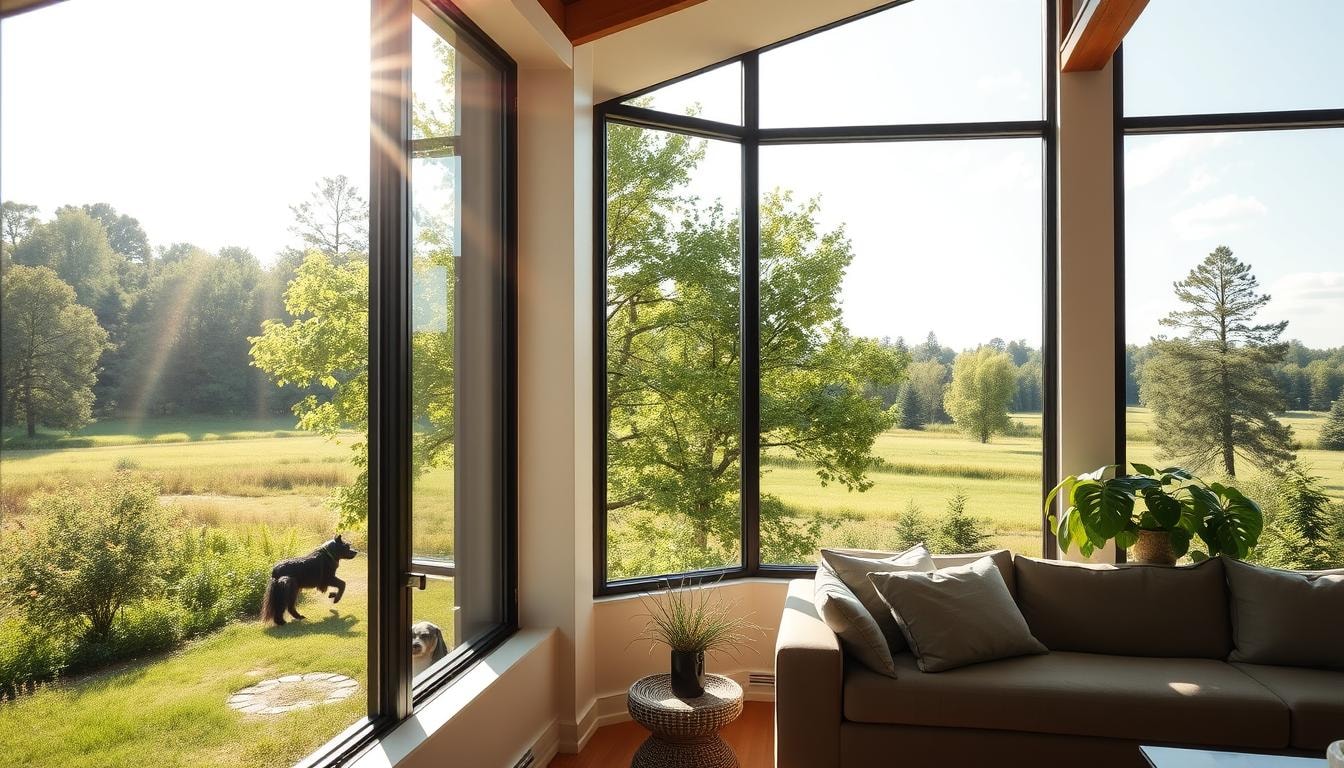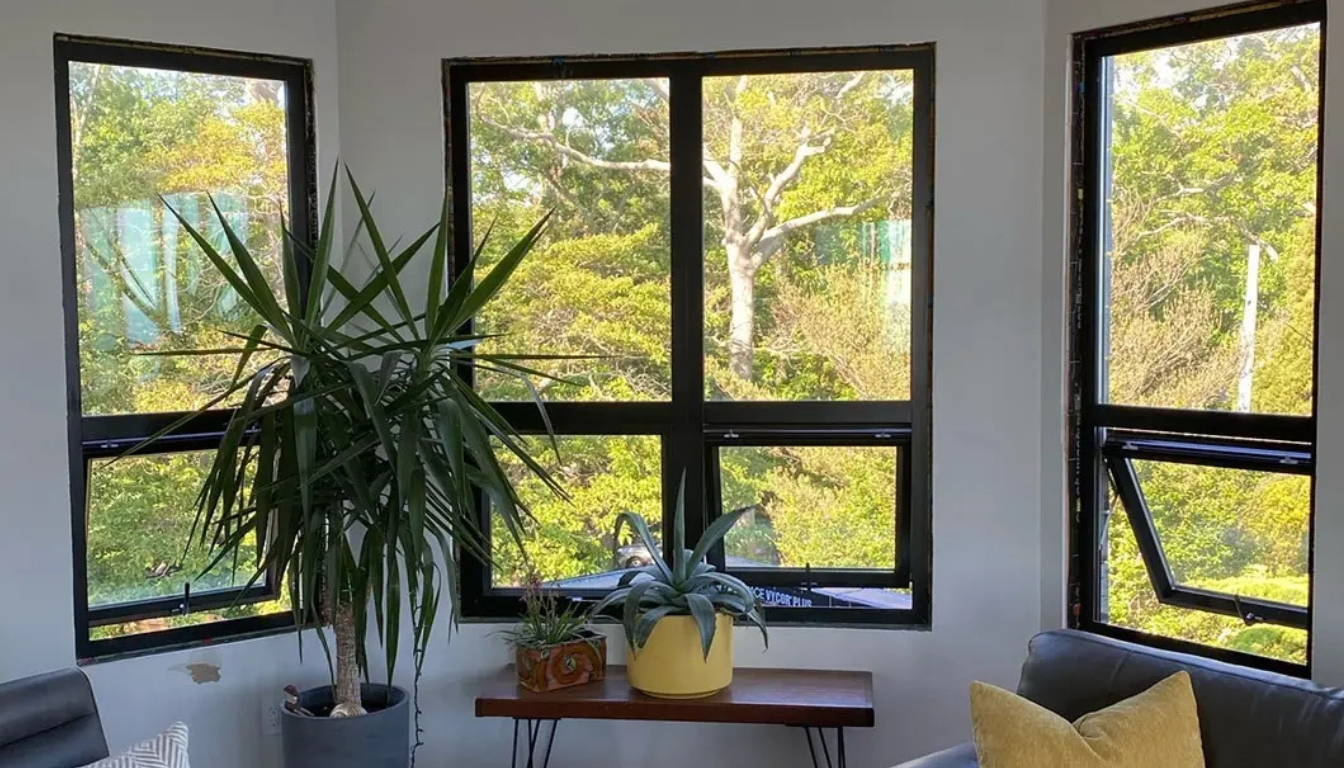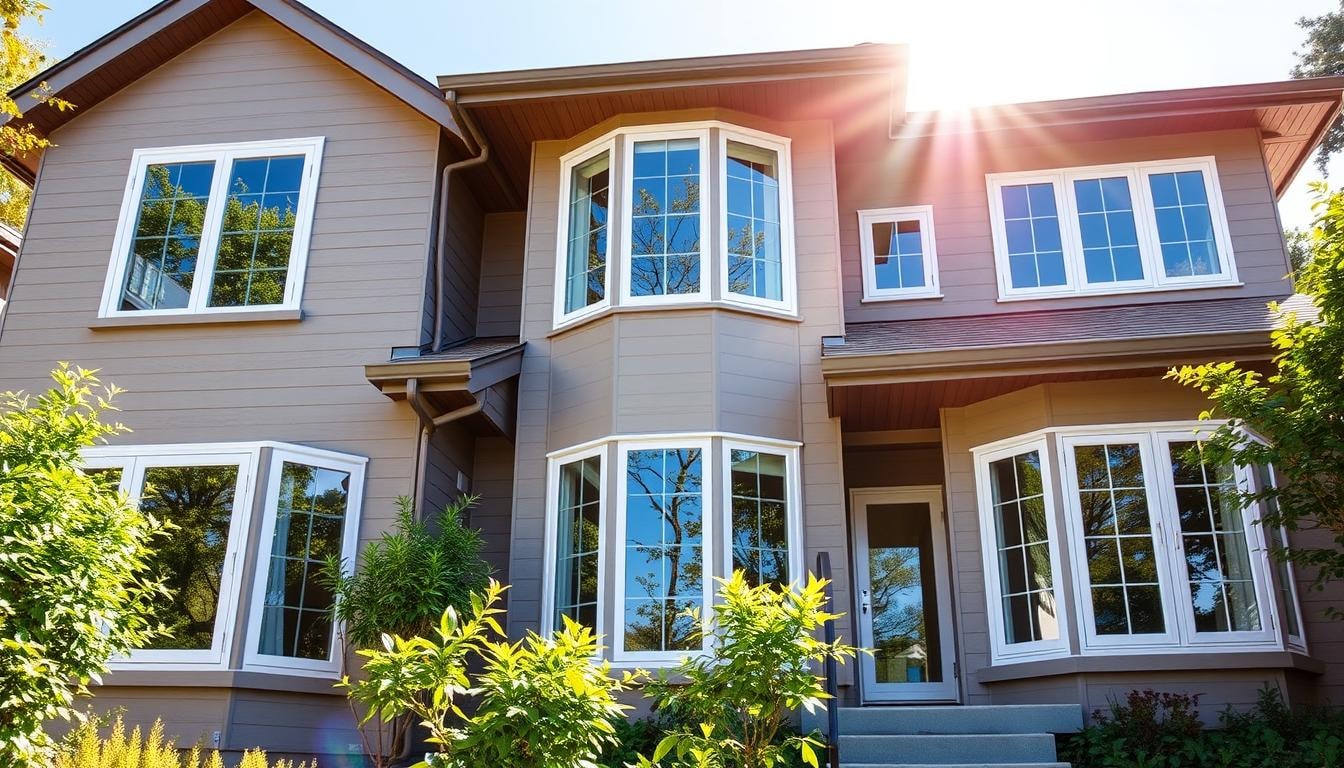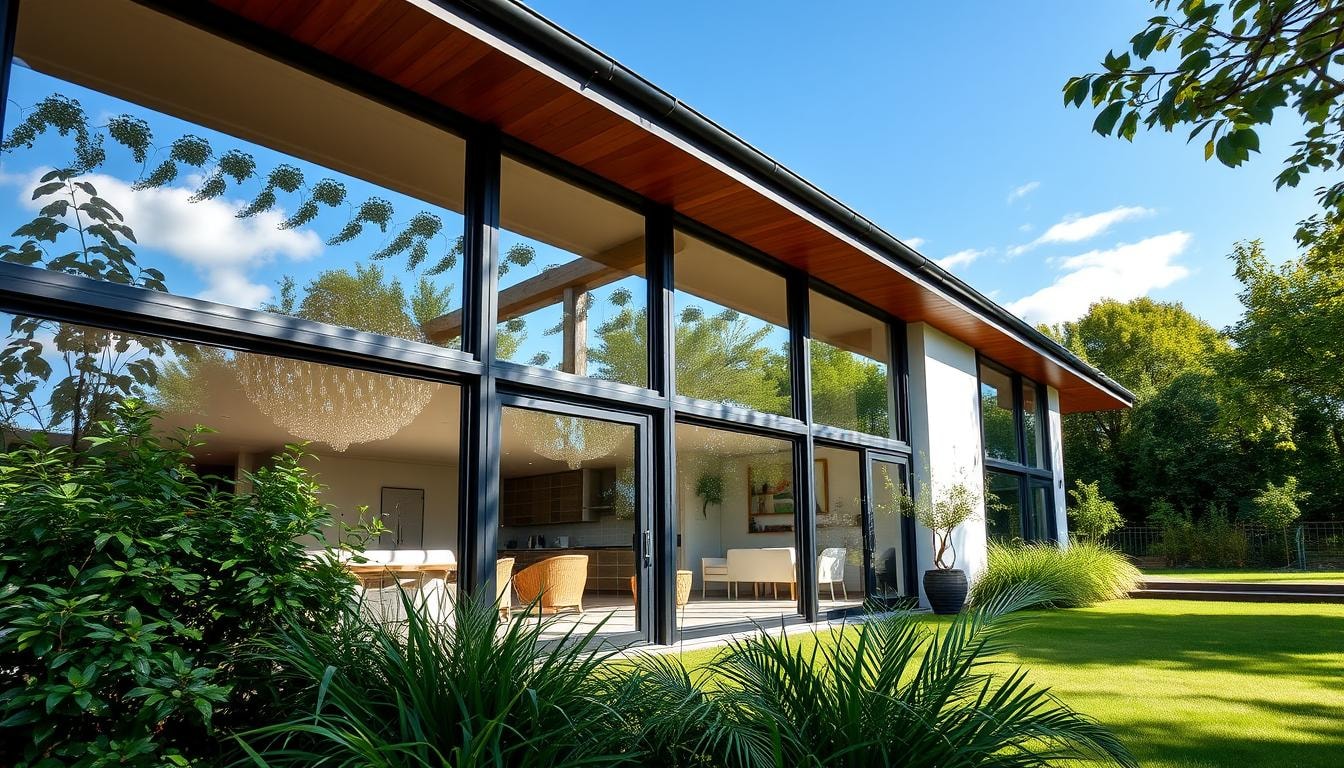
Most Energy Efficient Windows – Top Rated Guide
Homeowners in the U.S. spend about $1,452 a year on electricity. This makes energy-efficient windows a key investment. They help cut down on energy bills and make homes more comfortable. Triple-pane windows are especially good, offering up to 40% better insulation than double-pane ones, a study by the ASHRAE Journal found.
Switching to ENERGY STAR-qualified windows can save up to $500 a year. This makes them a wise choice for saving energy. Also, new tech like low-E glass coatings can cut energy loss by 50% while still letting in plenty of natural light.
Key Takeaways:
- The average American pays $1,452 annually for electricity, with potential savings of up to $500 per year by upgrading to energy-efficient windows.
- Triple-pane windows offer superior insulation, with up to 40% better efficiency than double-pane options.
- Low-E glass coatings can reduce energy loss by as much as 50% without impacting natural light.
- ENERGY STAR-certified windows are considered the most efficient options on the market.
- Energy-efficient windows can help homeowners save hundreds of dollars annually on heating and cooling costs.
Understanding Energy Efficient Windows
Energy-efficient windows help cut down on heat transfer. This means your home uses less energy and you pay less for it. They use new tech like multiple glass layers and special gases to block heat.
Knowing how windows work helps you pick the best ones. This improves your home’s energy use.
Basic Principles of Window Efficiency
Window efficiency comes from a few things. These are the number of glass layers, the coatings on the glass, and the gas between the panes. Good windows have double or triple glass and special coatings and gases.
Impact on Home Energy Consumption
Windows are key to a home’s energy use. They affect how much you spend on heating and cooling. Energy-efficient windows keep your home cooler in summer and warmer in winter.
This means lower bills and a cozy home. Knowing about the solar heat gain coefficient helps pick the right windows for your area.
Key Components of Efficient Windows
- Multiple glass panes (double-pane or triple-pane) for improved insulation
- Low-E coatings that reflect infrared and UV radiation
- Insulating gas fills (such as argon or krypton) between glass panes
- Warm edge spacers to reduce heat transfer at the window’s edges
- Durable and energy-efficient frame materials like vinyl or fiberglass
Knowing about these parts helps you choose the right windows. This makes your home more energy-smart.
Triple-Pane vs Double-Pane Windows Comparison
Homeowners often choose between double-pane and triple-pane windows. Each type has its own benefits. The best choice depends on the climate, budget, and personal taste.
Performance Differences
Triple-pane windows are better at keeping heat in and noise out. They have three layers of glass and two gas-filled spaces. This makes them 30% to 40% better at keeping heat in than double-pane windows.
Energy Star-rated triple-pane windows are 50% more efficient. They are great for homes in cold climates.
Cost Considerations
Triple-pane windows are more expensive. They cost 50% to 200% more than double-pane windows. Prices range from $1,800 to $3,000 per window.
But, they can save 2-3% on energy bills each year. This might make them worth the extra cost over time.
Installation Requirements
Triple-pane windows need stronger frames because they are heavier. This makes installation more complex and costly. It’s often better to hire a professional.
Double-pane windows are lighter and easier to install. They are a good choice for those who want to save money.
The choice between triple-pane and double-pane windows depends on your needs and budget. Triple-pane windows are more efficient but cost more. Double-pane windows are more affordable and come in many designs.
Energy Star Certification and Standards
Energy-efficient windows are key, and the Energy Star certification is important. The U.S. Environmental Protection Agency (EPA) gives this award. It means the windows save a lot of energy and cut down on pollution.
Looking for energy-efficient windows? Start with the Energy Star label. It shows you’re choosing a smart, green option. You’ll save money on bills and help the planet.
These windows are made for different climates in the U.S. They fit your local weather needs. This makes them work better for you.
- Energy Star-certified products can lower home energy bills by up to 13%.
- U-factor values for Energy Star-certified windows typically range from 0.25–1.25 Btu/h·ft²·degrees Fahrenheit.
- SHGC values for Energy Star-certified windows generally range from 0.25–0.80.
- Industry standards require an air leakage value of at least 0.3 cf·m/ft² for Energy Star-certified windows.
- VT values for Energy Star-certified windows range from 0.20–0.80.
Choosing Energy Star-certified windows brings many benefits. You get better energy use, insulation, and less pollution. The Energy Star label helps you make a choice that saves energy and is good for the planet.
Window Frame Materials and Their Efficiency
The frame material of energy-efficient windows is key to their performance. Vinyl, fiberglass, and wood are the most common. Each has its own benefits and things to think about.
Vinyl Frames Benefits
Vinyl frames are loved for being affordable and easy to care for. They stand up well to weather, don’t rot or rust, and need little upkeep. Plus, they’re great insulators, keeping heat in or out, making them a cost-effective choice.
Fiberglass Options
Fiberglass frames are a durable, weather-resistant option. They’re priced between vinyl and wood, offering a good middle ground. They also help keep energy in or out, boosting the windows’ energy efficiency.
Wood Frame Considerations
Wood frames are known for their natural insulation. They block air flow well. But, they need more care than vinyl or fiberglass. Wood frames are perfect for those who love a natural look and are ready to maintain them.
Choosing the right frame material for energy-efficient windows is important. Think about cost, upkeep, and how well they keep heat in or out. Vinyl frames are a good mix of price and insulation. Wood frames offer great insulation but need more care. Fiberglass is a balance of durability and energy efficiency.
Low-E Glass Technology and Coatings
Low-E glass technology is a big deal for energy-efficient windows. It has a thin metal oxide coating that reflects heat. This makes your home warmer in winter and cooler in summer, saving on energy bills.
Low-E glass also blocks harmful UV rays. This stops fabrics, furnishings, and flooring from fading. It keeps your home looking great, even in sunny places.
- Low-E glass coatings can help block the sun’s heat in summer and prevent heat from escaping in winter.
- Low-E glass can reduce fading to flooring and fabrics by decreasing the amount of UV light that passes through.
- Some Low-E coatings are better for insulating, making them suitable for northern climates, while others are ideal for blocking solar heat gain, more suitable for southern climates.
Choosing the right low-E glass is key. It depends on your home’s climate and energy needs. In Medford, OR, the right coating can keep your home comfy all year and cut utility bills.
Gas Fills and Insulation Technologies
Inert gases like argon and krypton are used in energy-efficient windows. They help keep the windows warm in winter and cool in summer. This makes the windows better at saving energy.
Argon Gas Benefits
Argon gas is a top choice for insulating windows. It’s about 67% better at keeping heat in than regular air. Windows filled with argon can help with up to 50% of a home’s heating and cooling needs, says the U.S. Department of Energy.
Argon gas is also affordable. It can last for decades, slowly leaking about 1% each year. This keeps it effective at insulating.
Krypton Gas Applications
Krypton gas is pricier than argon but insulates better. It’s best for triple-paned windows with small gaps. Krypton gas blocks heat transfer well, making it great for cold places or where energy savings are key.
Choosing between argon and krypton depends on the window size, insulation needs, and budget. Argon is cheaper for bigger gaps. Krypton is better for smaller gaps in triple-paned windows, offering big energy savings.
Insulating gases like argon, krypton, and xenon boost energy-efficient windows’ thermal performance. This leads to lower energy bills and a cozy home.
Energy Savings and Cost Benefits
Energy-efficient windows can save a lot on your energy bills. The savings depend on the type of windows, your location, and energy rates. Upgrading can save you $71 to $501 a year, says the U.S. Department of Energy.
The cost of these windows is between $150 and $6,500 each. On average, it’s about $400 per window. Even though it’s expensive upfront, the long-term savings make up for it. You can get back about 78% of the cost when you sell your home.
In places with very hot or cold weather, you’ll save even more. Larger windows or those with special features like low-E coatings save more energy. This means lower cooling costs and bills.
These windows also make your home more comfortable all year. They cut down on drafts and heat loss. This makes your home more efficient, saving you money on heating and cooling.
Even though it takes a long time to see the savings, energy-efficient windows are a good choice. They also make your home more attractive to buyers. This can increase your home’s value.
Advanced Window Design Features
Advanced design features in windows are key to better energy efficiency. Warm edge spacers and weather stripping are two important parts. They help windows work better.
Warm Edge Spacers
Warm edge spacers stop heat from escaping at window edges. They act as a barrier between the panes. This keeps the room temperature steady, saving energy and making it more comfortable.
Weather Stripping Solutions
Weather stripping is vital for energy-efficient windows. It seals the window frame tight, stopping air leaks. This keeps the air inside, reducing the need for extra heating or cooling.
Weather stripping is made from materials like rubber, foam, and vinyl. Each has its own strengths, like durability and flexibility.
These features, along with others like multi-pane construction and gas fills, make windows more efficient. They improve home comfort and save energy.
Climate-Specific Window Solutions
Energy-efficient windows come in many types. Each climate needs its own special windows. Knowing your climate helps pick the best windows for your home.
In cold areas, keeping heat in is key. The ASHRAE climate zone map helps find the right windows. For zones 2 to 8, windows should have a U-Factor of 0.40 or less. Zones 3 to 8 need a U-Factor of 0.30 or less.
In warm places, stopping heat from the sun is important. The Solar Heat Gain Coefficient (SHGC) is what matters most. For zones 0 to 3, SHGC should be 0.25 or less. Zones 4 and 5 aim for 0.40 or less.
Companies like Andersen make windows for different climates. Their Low-E4® glass keeps heat in winter and out in summer. Their triple-pane glass and frames also help keep your home warm or cool.
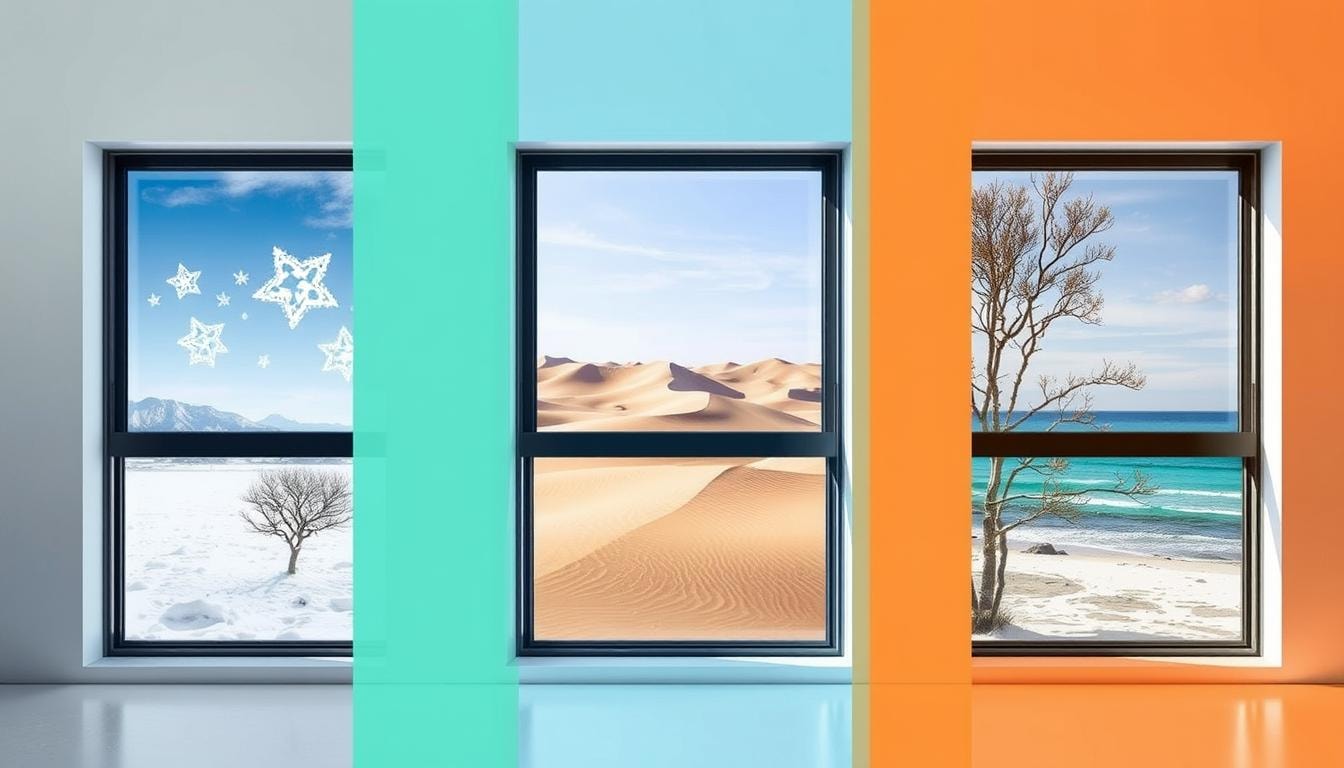
Choosing the right windows is key for a comfy and energy-saving home. Knowing your climate helps pick the best windows. This choice can make your home more comfortable and save energy.
Installation Considerations for Maximum Efficiency
Getting your windows installed right is key for saving energy at home. Whether you hire pros or do it yourself, knowing what to focus on is crucial. It helps your new windows work their best.
Professional vs DIY Installation
DIY window installation might save money, but it’s risky. Pros know how to fit, seal, and integrate windows perfectly. This ensures your windows work well, keeping your home cozy and saving energy.
But, DIY can lead to costly mistakes. If not done right, it can mess up your energy savings. This is because of air leaks and water getting in.
Common Installation Challenges
- Ensuring proper insulation around the window frame to minimize air leaks
- Maintaining the integrity of the building envelope to prevent heat transfer
- Properly sealing and flashing the windows to protect against water infiltration
- Aligning the windows for optimal operation and weatherproofing
- Verifying the compatibility of the new windows with the existing structure
By tackling these common issues, you can make your new windows super efficient. This way, you get the most out of your investment.
Maintenance Tips for Energy Efficient Windows
Keeping your energy-efficient windows in good shape is key. It helps them work well and save you money. Here are some tips to keep your windows running smoothly.
Cleaning and Inspection
Clean your windows often to get rid of dirt and grime. This keeps them clear and stops damage to the seals and coatings. Check for cracks or damage in the frames and seals. Fix any problems right away to keep your windows working right.
Weatherstripping and Caulking
Weatherstripping and caulking keep air out and your windows efficient. They can wear out, so check and replace them when needed. Keeping them in good shape helps your windows work better.
Hardware Maintenance
Look after the moving parts of your windows, like hinges and locks. Use lubricant as the maker suggests to keep them moving smoothly. This helps keep your windows sealed tight and energy-efficient.
By following these tips, your energy-efficient windows will keep saving you money. Regular cleaning and checks will make sure you get the most out of your windows.
Environmental Impact and Sustainability
Energy-efficient windows are key in lowering a home’s environmental impact. They help cut down on energy use, which means less carbon footprint. In the U.S., they can save up to 25% of energy, or about 1.1 million barrels of oil daily.
These windows are made from materials like vinyl, fiberglass, and wood. These materials are often recyclable, making the windows more sustainable. Also, window makers are using eco-friendly methods and recycled materials, making them better for the planet.
Carbon Footprint Reduction
Energy-efficient windows keep heat in or out, saving energy for heating and cooling. This leads to less greenhouse gas emissions. They can cut down household carbon dioxide by 1,006 to 6,205 pounds a year.
Recyclability Factors
- Vinyl frames are highly recyclable, contributing to the overall sustainability of energy-efficient windows.
- Fiberglass frames are durable and resistant to warping and cracking, making them a long-lasting and eco-friendly choice.
- Responsibly sourced wood frames are renewable and recyclable, aligning with the principles of sustainability.
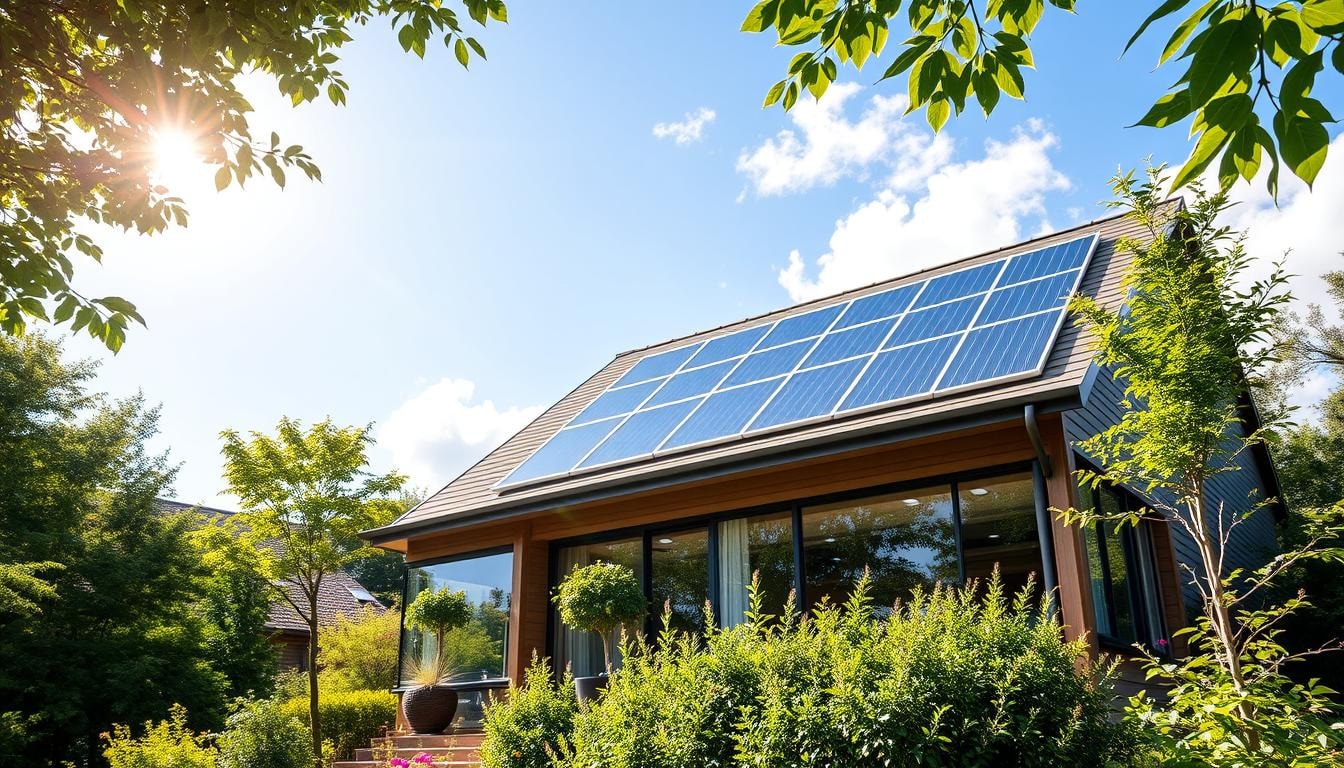
Choosing energy-efficient windows helps homeowners reduce their environmental impact. These windows save energy and money. They also help protect the planet for the next generations.
Tax Credits and Incentives
Getting energy-efficient windows can cost a lot. But, many places offer tax breaks and incentives to help. These programs, linked to ENERGY STAR, make it easier to upgrade. They also help save money on energy bills in the long run.
The Inflation Reduction Act brought new tax credits for energy-saving home upgrades. Homeowners can get up to $3,200 in tax credits for work done after January 1, 2023. This is until 2032. You can get up to $1,200 for energy-saving home improvements and up to $2,000 for certain appliances.
- The tax credit is 30% of the cost for things like energy-efficient windows and home energy audits.
- There’s no limit on how much you can get, so you can claim it every year until 2033.
- To qualify, the work must be on your main home in the U.S. There are specific rules for the products and installations.
States and utility companies also offer their own deals for energy-efficient windows. These can lower the cost upfront. This makes the investment more worth it.
Using these tax credits and incentives can greatly lower the cost of energy-efficient windows. This leads to savings on energy bills and a greener home.
Upgrade Your Windows with Budget Windows
At Budget Windows, we offer a wide range of energy-efficient window solutions to improve your home’s energy efficiency and comfort. Whether you need custom windows, double hung windows, or storm windows, our experts can help you choose the best option. Get in touch with us today for a comprehensive guide on how to reduce energy costs and make your home more energy-efficient.
Conclusion
Energy-efficient windows bring many benefits to homeowners. They help save money on bills and make homes more comfortable. They also help the environment.
The cost to buy them might be high at first. But, the long-term savings and benefits make them a good choice. When picking windows, think about how well they keep heat out and let light in.
Upgrading to energy-efficient windows can lower energy use and let in more natural light. Homes feel more comfortable too. These windows also help reduce carbon footprint, making them good for the planet.
There are tax credits and affordable options for these windows. They are a smart choice for those wanting to save energy and help the environment.
Energy-efficient windows are a great way to make homes better. They save money, improve comfort, and help the planet. By choosing wisely and getting professional help, homeowners can find the best fit for their needs.
FAQs
How can energy-efficient windows improve my home’s energy efficiency?
Energy-efficient windows help minimize heat transfer by using multiple panes of glass, special coatings, and insulating gas fills. This improves your home’s energy efficiency and reduces energy costs.
What are the most efficient windows available?
The most efficient windows are those with multiple panes, low-E coatings, and insulating gas like argon or krypton. Triple-pane windows offer the highest efficiency, providing great noise reduction and saving on energy costs.
How do double hung windows compare to other window types in terms of energy efficiency?
Double hung windows, with two layers of glass, are a good choice for many homeowners seeking energy-efficient options. They help minimize heat transfer and contribute to the overall efficiency of your HVAC system.
What are the benefits of custom windows for energy savings?
Custom windows, like picture windows or storm windows, are designed to meet your specific needs. They help maximize energy efficiency by minimizing heat transfer and offering other features like improved noise reduction.
Why should I consider upgrading from old windows to energy-efficient models?
Replacing old windows with energy-efficient models, such as casement windows with triple panes or awning windows, can drastically improve your home’s energy efficiency. The third pane and additional features provide better insulation and lower energy costs.





